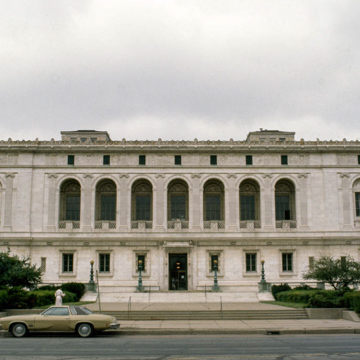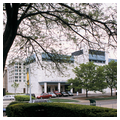The Detroit Institute of Arts (DIA) is a civic monument in white Vermont marble that relates to the library ( WN61) across Woodward Avenue and fulfills a portion of the City Beautiful program. It was designed by Philadelphia architect Cret. Born in France, Cret was trained at the Ecole des Beaux-Arts, and his work is both rational and urbanely French. In this building the triple-arched entrance, rhythmic windows, low profile, and curved entrance drive all signify his controlled approach. The galleries were arranged so that paintings could be displayed with sculpture and furniture in architectural settings that gave each room the same style as the art it contained. Historian Elizabeth Grossman noted, in a paper given in Montreal, Canada, in 1989, that this resulted from the “heterogeneity of intention” of Cret; of Wilhelm Valentiner, a German émigré director; and of the City of Detroit's Arts Commission. The Detroit Industry mural devoted to the auto industry and painted by Diego Rivera in 1932–1933 is in Rivera Court. In the Wall Street Journal (August 14–15, 2010), Tom L. Freudenheim suggested we view these powerful paintings as a summons to renewed greatness.
Noted Postmodern architect Graves was selected in March 1989 to design the master plan for a renovation and addition that integrates the overall Cret composition. Graves created a design that blended a restrained, conservative, classical-inspired exterior with an unclogged interior. (The DIA removed the polished dark gray granite that clad the north and south wings in the 1960s and 1970s and replaced it with white marble meant to evoke a neoclassical ambience with lots of plain marble wall.) Graves wrapped the north and south wings in white marble distinctively brighter than that of the original building so that the observer recognizes the difference between the two—in deference to the Cret work. A new spine or circulation corridor runs from the south entrance off Farnsworth on a straight line to the north side of the museum, opening up the labryrinth created by multiple additions and renovations. This north–south two-floor passageway also serves as gallery space.
The DIA rethought its fundamental philosophy, taking a more populist stance by marketing its installations to a nonexpert audience as opposed to art connoisseurs. Director Graham Beal created a lively interactive way of displaying and labeling the art. In 2010 the DIA opened its Gallery of Islamic Art. Yet, in 2010 the DIA suffers budget shortfalls.







